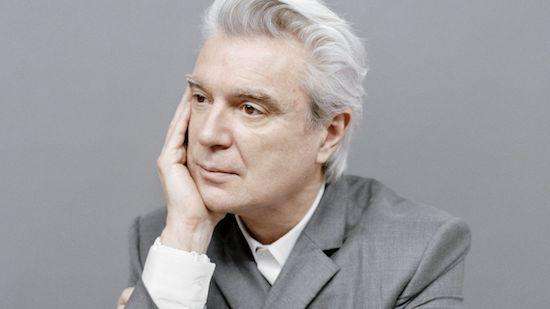David Byrne Promotes ‘American Utopia’—The Album & The Idea—At Brooklyn Concert
Via Billboard

Photo by Jody Rogac
By John DeFore
David Byrne was behind a small desk, alone on the big empty stage and barely moving. He sat like the late Spalding Gray, his onetime contemporary on New York's downtown art scene (and like Byrne, the subject of one of Jonathan Demme's groundbreaking performance films), and as Gray occasionally did, he focused on a prop as the backdrop transformed around him: Holding a model of a human brain, Byrne pointed to one spot after another and sang, "Here is a region that is seldom used...here is an area of great confusion...here is an area that needs attention."
The song "Here" is one of several on Byrne's latest album, American Utopia, that turns the focus inward, the speaker examining how he thinks, behaves and dances -- the better to observe, on other songs, the strange and often upsetting behavior of others. In a concert at Brooklyn's Kings Theatre on Sept. 17 that devoted ample attention to Byrne's early years with Talking Heads but still felt very much of this moment, Byrne and about a dozen bandmates embodied the singer's ideals -- exuberance, cooperation, diversity and curiosity -- while acknowledging forces outside the venue promoting just the opposite. All this while paying as much attention to showmanship as he did in that Demme film, Stop Making Sense.
While he performed that opening song, collaborators snuck onstage, parting the beaded-curtain backdrop to emerge in all-gray suits (and bare feet) identical to Byrne's. They had filled the stage by the set's second number, the unexpected U.K. dance hit "Lazy," and their evocation of a military marching band clicked thrillingly into place for "I Zimbra," the first of many songs drawn from the Talking Heads catalog.
Their formations were choreographed by Brooklynite Annie-B Parson, whose previous work with Byrne includes the brass-band tour he mounted with St. Vincent and his 2008 Songs of David Byrne and Brian Eno stage show, the subject of his concert film Ride, Rise, Roar. Here, Parson devoted much of her attention to two backup singers who doubled as dance soloists, often giving them cryptic hand and arm movements that recalled Byrne's famous moves in Stop Making Sense. If Byrne himself was sometimes too focused on a song to match his partners' moves, he was fully committed to some impressively athletic bits elsewhere in the show, like the hopscotchy backward dance on "I Should Watch TV," where his feet whipped around quickly enough they'd have kept hula hoops aloft.
"Lazy" aside, Byrne only did one other song from an album credited to him as a solo artist before this new one: A buoyant "Like Humans Do," from Look Into the Eyeball, may have had serious Byrne fans wishing for other songs from his solo years. But few would fault him for pleasing the crowd with Heads favorites like "Burning Down the House" and "Once in a Lifetime"; and one of those old hits did double-duty as a demonstration that, as Byrne put it, he wasn't up to any Milli Vanilli shenanigans: The singer says he realized months ago that some fans thought he was fleshing out the band with samples or prerecorded playback tracks. So before launching into a walloping "Born Under Punches (The Heat Goes On)," Byrne introduced his band members one by one, each of them adding his or her beat to the polyrhythmic groove being assembled before our ears.
With the title of his new record and the optimistic way he introduced it to the world (he gave a series of multimedia presentations, titled "Reasons to be Cheerful," that showcased innovation and community-building around the globe), a casual observer might accuse Byrne of wishful thinking when it came to the state of the world. But while the songwriter used humor as a political tool (in "Dog's Mind") and pushed simple steps like voter registration, two of the night's most captivating moments voiced horror and outrage: For the new album's haunting "Bullet," which mixes graphic imagery with everyday details in its elegy for a shooting victim, the singer was illuminated by a bare light bulb as his bandmates marched dolefully around the stage's periphery. And for the second encore, instead of sending fans off with another greatest hit, Byrne covered Janelle Monae's protest anthem "Hell You Talmbout": As the band pounded out an insistent beat, Byrne or pairs of band members would step forward, shouting the names of black victims of violence and imploring the crowd to "Say his name! Say his name! Say his name!"